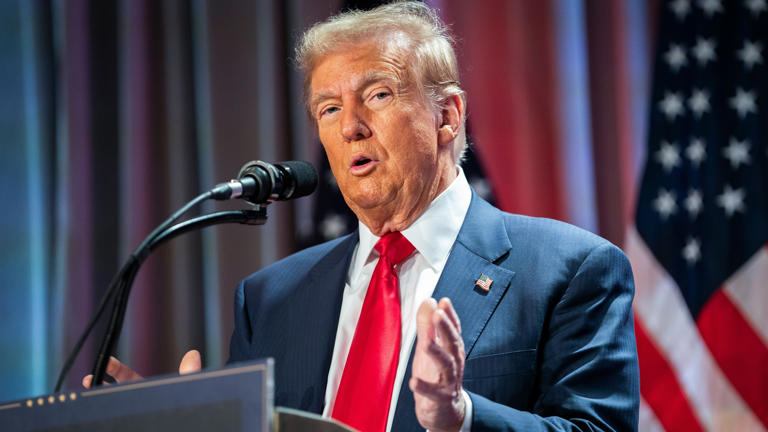Donald Trump’s inauguration as U.S. president will take place on January 20, 2025, with the world gearing up for his tariffs.

Although the actual period over which the tariffs will be introduced and implemented will depend on future negotiations, it is expected that if tariffs are adopted, the PRC’s real economic growth rate will drop to about 1 percent by 2035, which will have a significant impact on the world economy.
During the election campaign, Trump publicly stated that he would impose a 60 percent tariff on Chinese products. In November 2024, it was announced that an additional 10% tariff would be imposed on almost all goods imported from the PRC and a 25% tariff on Mexico and Canada. There are uncertainties in Trump’s speech and there are still variables in the tax rate, but many analysts believe for sure that Trump will take steps to increase tariffs.
Any increase in tariffs would have a huge impact on the Chinese economy. According to calculations by the Japan Economic Research Center, if the United States of America imposes additional tariffs of 60 percent on RPC, and 10 percent on other states and regions, and if those countries do not take retaliatory measures, China’s gross domestic product (GDP) growth is expected to drop from 4.7 percent in 2024 to 3.4 percent in 2025 and 1.8 percent in 2035.
If the additional tariff were 10%, Chinese exports would decline by 2.3%, while if it were 60%, they would decline by nearly 14%. If China’s tariffs on PR were to reach 60%, Chinese exports of clothing, footwear and toys, which account for a high percentage of U.S. imports, could be significantly reduced.
China has not yet proposed countermeasures, but is not cautious about retaliation. As the Chinese Ministry of Commerce said, “China’s stance against unilateral tariff increases is consistent.”
In the Sino-US trade war held in 2018 and 2019, China has targeted soybeans and other agricultural products grown in the United States of America, as the first set of retaliatory tariffs. The move aimed to target farmers, among whom are many Trump supporters. In recent years, the PRC has reduced soybean imports from the United States of America and increased purchases from South America, promoting diversification of import sources. If trade frictions develop again this time, agricultural products could become targets for retaliation.
Statistics from the U.S. Department of Commerce show that Washington’s trade deficit in 2023 increased overall by 44 percent , compared to 2016, the previous year of President Trump’s first term. Although the U.S. trade deficit with the People’s Republic of China has decreased by 20 percent, the People’s Republic of China is still the country with the largest trade deficit for the United States of America.
The U.S. trade deficit with the European Union increased by 42 percent over the same period, while the deficit with Mexico rose 2.4 times.
Mexico has replaced China, ranking first in the volume of U.S. imports. Moreover, the United States of America accounts for 80 percent of Mexican exports, with more than 20 percent of the total being automobiles and automobile parts. In recent years, major Japanese, U.S. and European automobile manufacturers, including the three largest automakers, have upgraded production facilities in Mexico.
These manufacturers have promoted increased production on the premise of using the U.S.-Mexico-Canada Agreement ( USMCA), which can foresee zero tariffs if a number of conditions are met. This agreement is the result of a renegotiation oftheNorth American Free Trade Agreement by its member states, which agreed to the deadlines informally on Sept. 30, 2018, and formally on Oct. 1 of the same year. The USMCA, proposed and signed by the U.S. President Trump, was also signed by Mexican President Enrique Peña Nieto and Canadian Prime Minister Justin Trudeau on November 30, 2018 as a side event of the G20 Summit in Buenos Aires.
Mexico has called on the United States of America for caution, arguing that any increase in the price of cars sold in the United States of America. would create obstacles to policies to combat inflation, seen as one of the reasons for Trump’s overwhelming victory in the presidential election. Thus, the possibility of a trade war between the three countries that signed the USMCA free trade agreement is also looming because of Trump’s tariffs.
Europe has also been plagued by trade issues during Trump’s first term as president. So, European Commission President von der Leyen has signaled her intention to actively engage in “agreements” with Trump.
Both at the EU and member state level, it is hoped to avoid a situation where friction with the United States of America causes a negative impact on the economy. Especially Germany, which accounts for 40 percent of the U.S. trade deficit with the EU. As a trading partner for major commodities such as pharmaceuticals, machinery and automobiles, the United States of America likely has replaced China as Germany’s main trading partner in 2024. So, an increase on U.S. tariffs will further hit the long-stagnant German economy.
The U.S.-based Goldman Sachs Group estimates that if 10 percent duties were imposed on all goods imported to the United States of America, including Europe, eurozone GDP would fall by 1 percent. Germany could suffer an additional 1.1 percent decline.
The President of the European Central Bank (ECB), Christine Lagarde, expressed concern in her December speech saying that “if the United States resorted to trade protectionism, it is likely that eurozone growth would suffer.” Similarly to Ursula Von der Leyen, President of the European Commission, Christine Lagarde called for the continuation of trade negotiations rather than a retaliatory tariff war.
Although Trump did not specifically mention tariffs against Japan during the presidential election, that country could also be targeted. In fact, when Trump first took office, he hinted that he would impose an additional 25 percent tariff on Japanese cars and parts. Through Japan-U.S. trade negotiations, which took place in 2019, Japan avoided further tariffs, however, it had to agree to a gradual reduction of Japanese tariffs on beef imported from the United States of America. Japan is likely to be asked to negotiate again, as Trump has stated that he will apply the same tariffs that other countries impose on U.S. goods.
Author: Giancarlo Elia Valori – Honorable de l’Académie des Sciences de l’Institut de France, Honorary Professor at the Peking University.
(The views expressed in this article belong only to the author and do not necessarily reflect the views of World Geostrategic Insights).







